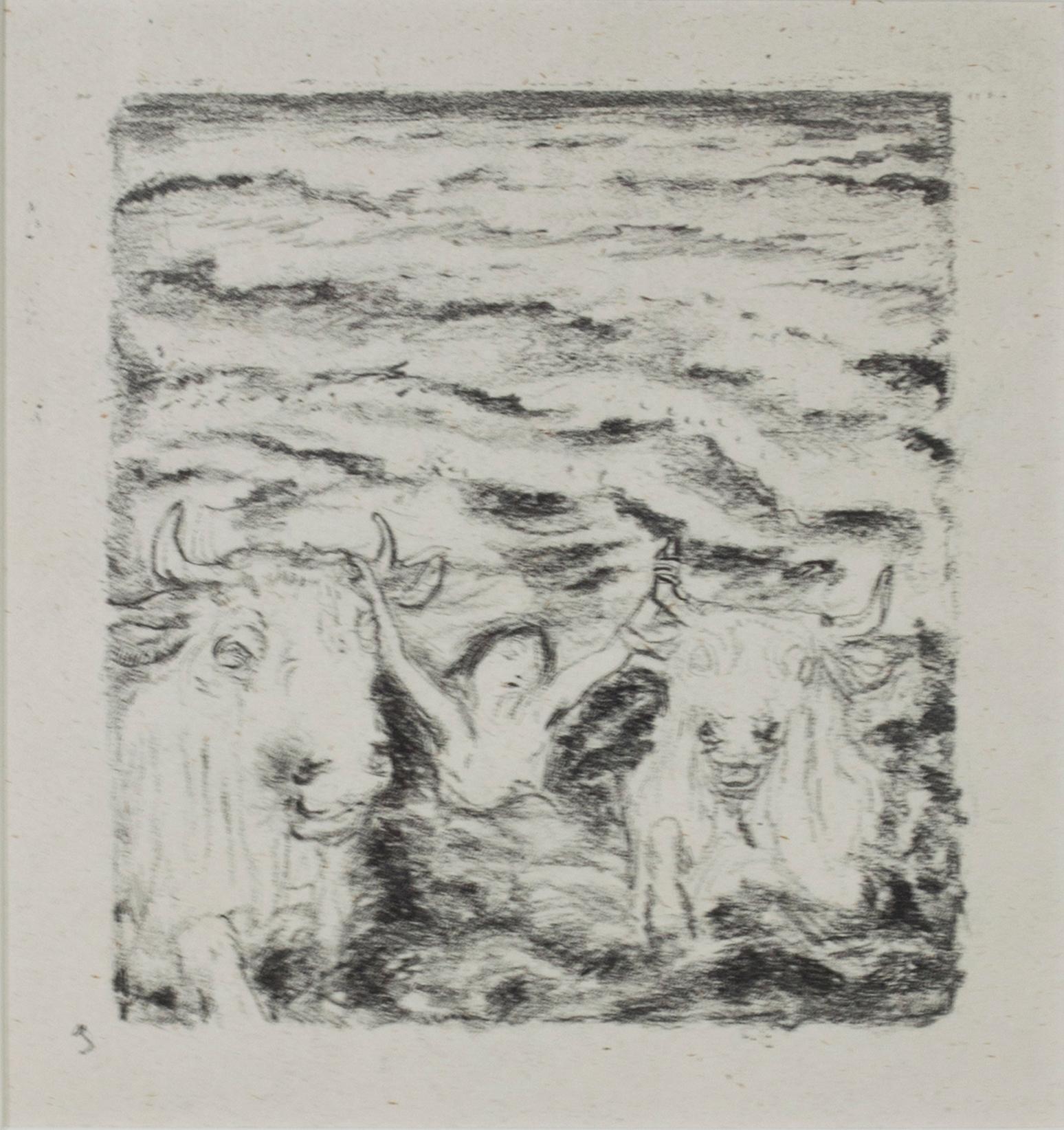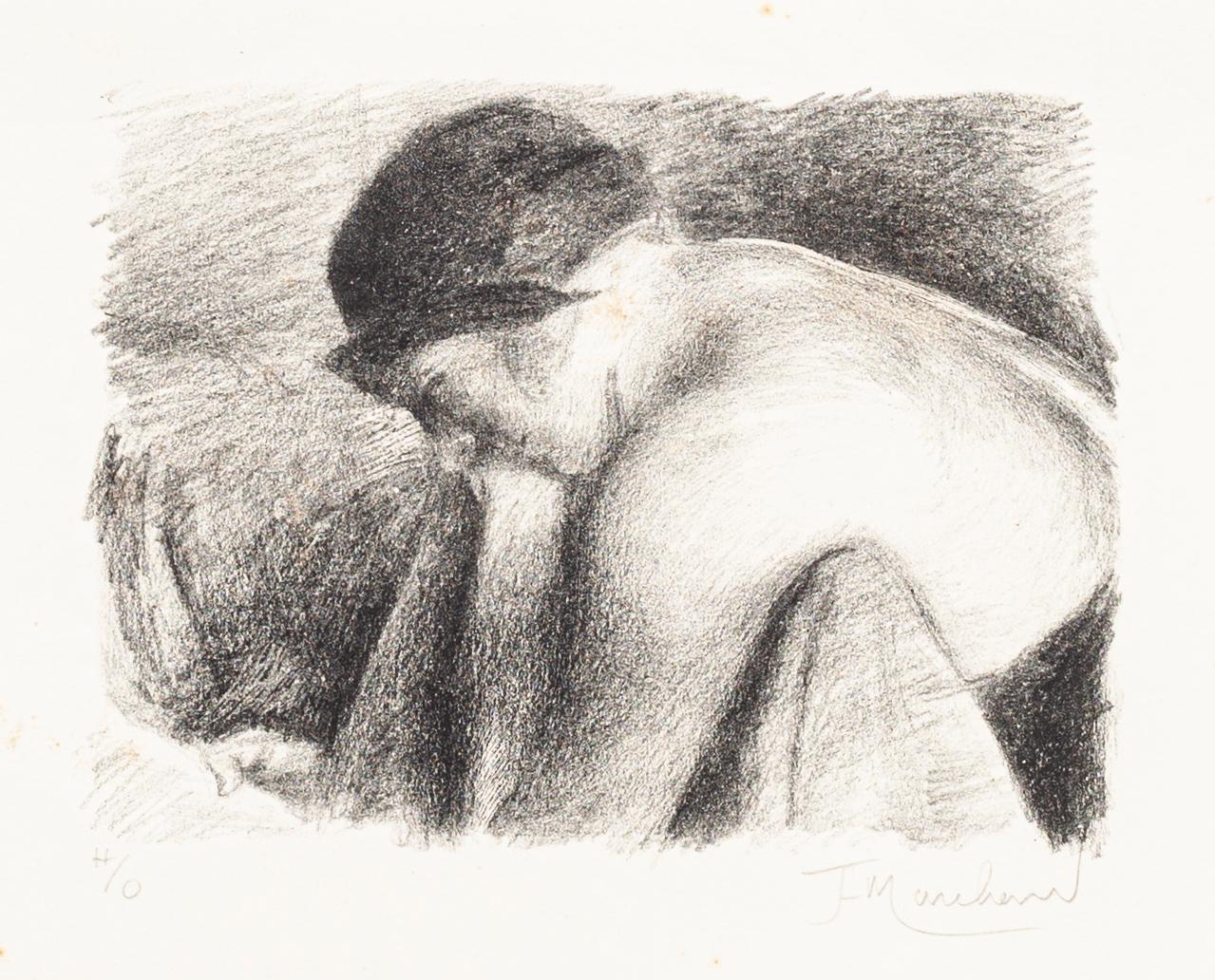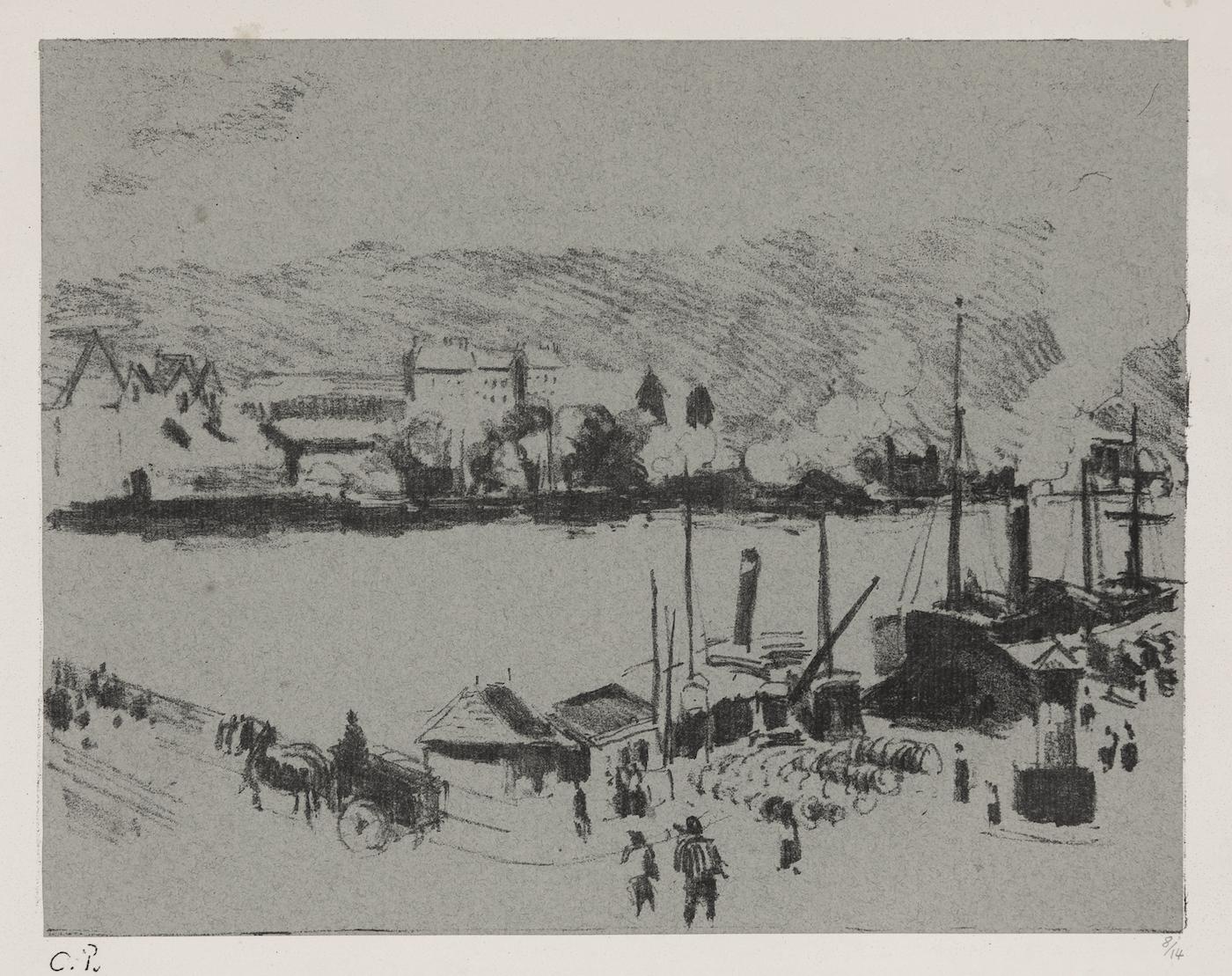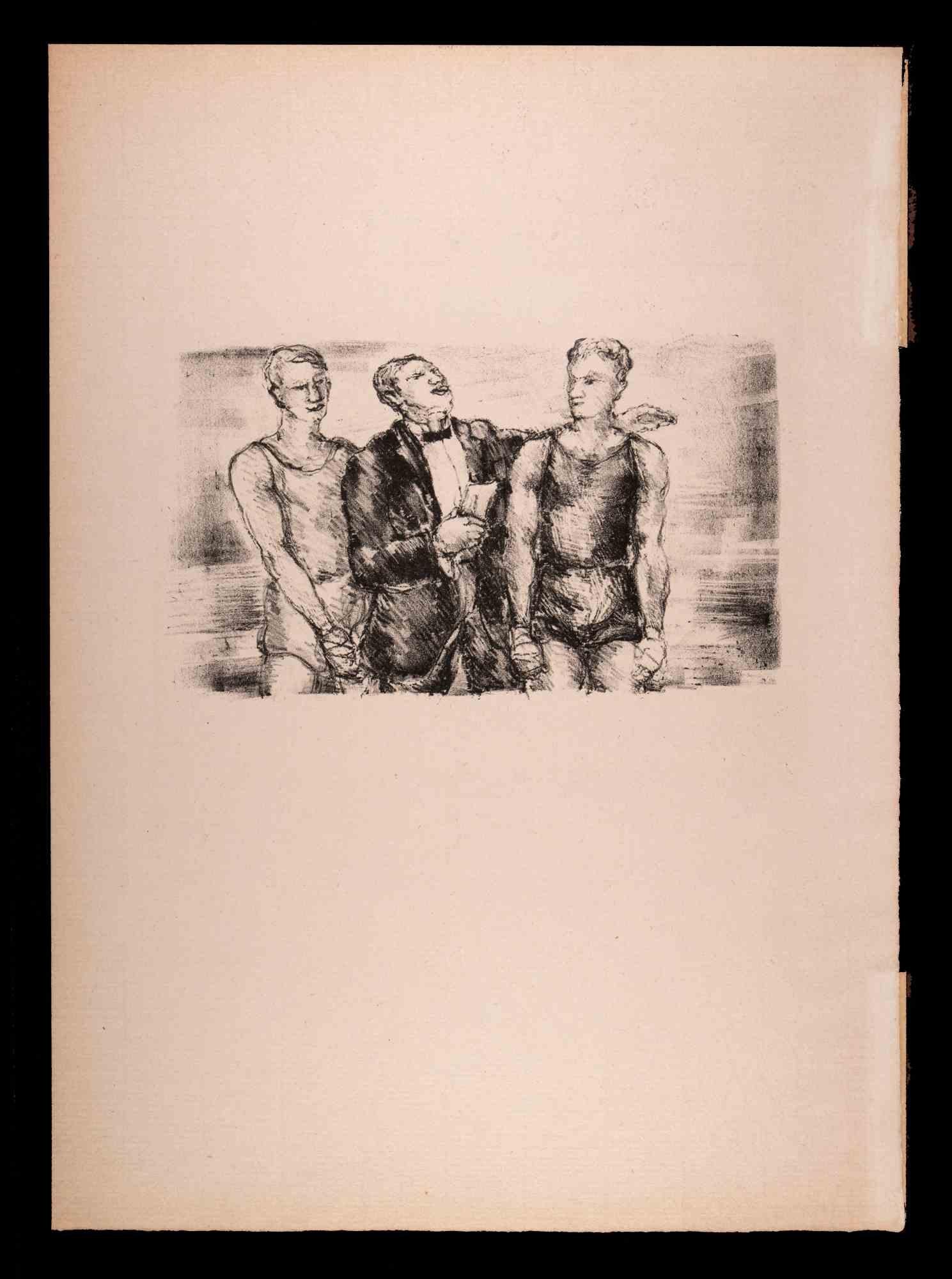Edouard VuillardCouverture pour Douze Lithographies en Couleurs, ou Passage et Interieurs1896-1898
1896-1898
About the Item
- Creator:Edouard Vuillard (1868-1940, French)
- Creation Year:1896-1898
- Dimensions:Height: 20.25 in (51.44 cm)Width: 15.75 in (40.01 cm)
- Medium:
- Movement & Style:
- Period:
- Condition:
- Gallery Location:Fairlawn, OH
- Reference Number:
Edouard Vuillard
French artist Edouard Vuillard was known for depicting intimate glimpses of Parisian life around the turn of the 20th century. His figurative prints, drawings and figurative paintings were concerned not just with their subjects but with the private surroundings of their homes and gardens. Vuillard was strongly influenced by Postimpressionist painters like Paul Gauguin.
Vuillard was born in the French commune of Cuiseaux in 1868. His family moved to Paris in 1877, and six years later, he received a scholarship to study at the prestigious Lycée Fontaine (now called the Lycée Condorcet). He graduated in 1885, joined the studio of painter Diogène Maillart and enrolled in courses at Académie Julian. Two years later, he was also accepted to the École des Beaux-Arts.
In 1889, the young Vuillard began meeting with a group of Symbolist painters and mystics known as Les Nabis (the prophets). For the subsequent decade, he was a prominent member of the group. During this period, Les Nabis and Vuillard himself were influenced by Japanese woodblock prints, featuring a blending of shapes and colors and a shallow depth of field. Any figures in the paintings seemed to meld into the background, and the loose brushwork prefigured the advent of abstract art.
Les Nabis broke up in 1900, and Vuillard's work took on a brighter and more colorful appeal. He turned his attention to painting gardens, joining a rich tradition of French garden painters. Vuillard was nominated for the Légion d'honneur in 1912, but he refused on the grounds that he did not seek compensation for his work other than the esteem of people with good taste.
After a brief stint in the military during World War I, Vuillard returned to life as a painter. In the 1920s, he was commissioned for portrait paintings by prominent Parisians like director Sacha Guitry, the Contesse Marie-Blanche de Polignac and fashion designer Jeanne Lanvin.
Throughout the 1930s, Vuillard received numerous commissions from the French government. In 1938, he had a major retrospective at the Musée des Arts Decoratifs and was elected to the Académie des Beaux Arts. He died in 1940, at the age of 71.
On 1stDibs, find Edouard Vuillard prints, drawings and paintings.
- ShippingRetrieving quote...Ships From: Akron, OH
- Return PolicyA return for this item may be initiated within 10 days of delivery.
- Les Amateurs d'EstampesBy Félix VallottonLocated in Fairlawn, OHLes Amateurs d'Estampes Woodcut, 1892 Initialed in the plate lower left Titled below image: "Gravure originale sur bois par F. Vallotton" Reference: Valloton and Goerg 107c, with the purple address stamp upper right center (see photo) Condition: Excellent Aging to sheet One spot of printers ink outside of the image in the upper margin Block size: 7 3/8 x 10 inches Sheet size: 10 1/8 x 12 3/4 inches Condition: Very good, aging (yellowing) to the paper Provenance: Edmund Sagot (1881-1917), noted Parisian art dealer and print publisher By decent Vallotton was a noted member of the Nabi, highly regarded for his paintings and original woodcuts. His works are in most major museums. Thank you for your interest in the Vallotton woodcut, Les Amateurs d’Estampes (Print Lovers). It depicts print collectors admiring the new offerings in the window of the Sagot Gallery in Paris. The woodcut is the second published version of the address card for Edmund Sagot the noted Paris art gallery with the change of address in lavender ink. It had moved and hence the change of address was necessary for publicity. The woodcut was created in 1892. It is unsigned as all the address cards are. There are two size variants, this being the larger of the two. It is printed on a tan wove paper. It is in excellent original condition. The provenance is from the Heirs of Edmund Sagot (1857-1917). by decent. The Sagot family was noted for selling posters, fine prints and original works of art. Edmund’s brother Clovis, was Picasso’s first dealer in Paris. The image is documented in the Vallotton and Goerg catalog raisonne in entry 107c Impressions of this image can be found in many museums including: Bibliothèque nationale de France De Young/Legion of Honor/Fine Art Museums of San Francisco Newfields, Indianapolis Museum of Art National Gallery of Australia Musee Des Beaux-Arts du Canada Van Gogh Museum Museum of Fine Arts, Houston Portland Art Museum Kunst Museum, Holland Philadelphia Museum of Art Yale University Art Gallery Félix Vallotton, in full Félix Edouard Vallotton, (born December 28, 1865, Lausanne, Switzerland—died December 28, 1925, Paris, France), Swiss-born French graphic artist and painter known for his paintings of nudes and interiors and in particular for his distinctive woodcuts. Vallotton was raised in a traditional bourgeois and Protestant household. After completing secondary school, he left Lausanne in 1882 for Paris to pursue art studies. Though he was accepted by the École des Beaux-Arts, he chose to attend the less traditional Académie Julian, where he studied with French painters Jules Lefebvre and Gustave Boulanger and enjoyed virtually free rein over his pursuits. He took the opportunity to study graphic arts—lithography and other methods of printmaking. He exhibited publicly for the first time in 1885 at the Salon des Artistes Français—the oil painting Portrait of...Category
1890s Post-Impressionist Figurative Prints
MaterialsWoodcut
- SevillanasLocated in Fairlawn, OHSevillanas Etching and color aquatint on laid watermarked paper, c. 1900 Signed by the artist in pencil lower right (see photo) Editioned in pencil lower left corner of sheet Publish...Category
Early 1900s Post-Impressionist Figurative Prints
MaterialsAquatint
- Le monocycle (Performer on a Unicycle)By Bernard BuffetLocated in Fairlawn, OHLe monocycle (Performer on a Unicycle) Color lithograph, 1968 Signed and numbered in pencil lower left corner From the portfolio "Mon Cirque" (My Circus) Edition: 120 (12/120) Reference: Sorlier, Buffet Lithographs, No. 166 Condition: Excellent Image size: 26 3/4 x 18 1/2 inches Sheet size: 28 1/4 x 20 inches Provenance: Robert Henry Adams, Chicago From Wikipedia, the free encyclopedia Bernard Buffet Born 10 July 1928 Paris, France Died 4 October 1999 (aged 71) Nationality French Education École Nationale Supérieure des Beaux-Arts, Marie-Thérèse Auffray Known for Painting, Drawing, Printmaking Movement Expressionism Awards Member of the Salon d'Automne, 1947 Member of the Société des Artistes Indépendants, 1947 Prix de la Critique, 1948 Prix Puvis de Chavannes, 1950 Officer of the Légion d'Honneur,1973 Member of the Académie des Beaux-Arts, 1974 Bernard Buffet (French: [byfɛ]; 10 July 1928 – 4 October 1999) was a French painter, printmaker, and sculptor. He produced a varied and extensive body of work. His style was exclusively figurative. The artist enjoyed worldwide popularity early in his career but was shunned by art pundits later on. Today, there is a renewed interest in Bernard Buffet's oeuvre. His works can be seen in the collections of the world's leading museums, including the Musée d'Art Moderne de Paris, the Tate, and the Museum of Modern Art. Biography Bernard Buffet was born in 1928. He hailed from a middle-class family with roots in Northern and Western France. His spent his childhood in Paris. His mother often took him to the Louvre Museum, where he got familiar with the works of Realist painters, such as Gustave Courbet. This is likely to have influenced his style. In 1955, he painted a work that paid tribute to Courbet's Le Sommeil. Bernard Buffet was a student at the Lycée Carnot during the Nazi occupation of Paris. He travelled to drawings courses in the evenings despite the curfew imposed by the Nazi authorities. He then studied art at the École Nationale Supérieure des Beaux-Arts (National School of the Fine Arts) and worked in the studio of the painter Eugène Narbonne. Among his classmates were Maurice Boitel and Louis Vuillermoz. He met the French painter Marie-Thérèse Auffray and was influenced by her work. Buffet's mother, Blanche, died from breast cancer in 1945. Seventeen-year-old Buffet...Category
1960s French School Figurative Prints
MaterialsLithograph
- Passage du Mont Saint-BernardBy Jean Louis Andre Theodore GericaultLocated in Fairlawn, OHTheodore Gericault (1791-1824) Passage du Mont Saint-Bernard Lithograph, 1822 Signed and titled in the stone As published in Arnault "Vie politique et militair...Category
1820s Romantic Figurative Prints
MaterialsLithograph
- Retour (Homecoming)By Georges De FeureLocated in Fairlawn, OHRetour Color lithograph, 1897 Signed in the stone lower left edge of the image (see photo) As published in "L'Estampe Moderne" L'Estampe Moderne appeared each month as a portfolio of...Category
1890s Art Nouveau Figurative Prints
MaterialsLithograph
- untitled (Woman with Hands on Hips)By Rudolf BauerLocated in Fairlawn, OHuntitled (Woman with Hands on Hips) Lithograph on tan wove paper, c. 1910's Signed in pencil lower right and in the plate, lower right (see photo) Edition: c. 100 Condition: Excellent Image size: 11-1/4 x 4-1/2 inches Sheet size: 18 1/8 x 11 3/8 inches Provenance: Estate of the Artist Borghi & Company, New York Herb Lerner, Boca Raton, FL Rudolph Bauer 1889-1953 Rudolf Bauer was born in Lindenwald near Bromberg, Silesia, in 1889 but his family moved only a few years later to Berlin. In 1905 Bauer began his studies at the Berlin Academy of Art but left the Academy only a few months later to educate himself. The upshot was paintings, caricatures and comical drawings which were published in 'Berliner Tageblatt', 'Ulk' and 'Le Figaro'. From 1912 Bauer contributed to the magazine and Gallery 'Der Sturm' founded by Herwarth Walden and pivotal to German Expressionism and the international avant-garde. In 1915 Rudolf Bauer participated for the first time in a group show at Walden's gallery. There he met Hilla von Rebay, with whom he began a relationship of many years that was crucial to Bauer's later work. By 1922 Bauer had shown work at about eight exhibitions mounted by 'Der Sturm'. From 1918 he also taught at the 'Der Sturm' art school, where Georg Muche was the director. After the war ended, Bauer was a founding member of the 'November Group' although he did not collaborate closely with the group. In 1919 Bauer joined forces with the painter and architect Otto Nebel...Category
1910s Expressionist Figurative Prints
MaterialsLithograph
- "Daphnis et Chloe (Two Bulls & Person in Water), " Lithograph signed by BonnardBy Pierre BonnardLocated in Milwaukee, WI"Daphnis et Chloe (Two Bulls & Person in Water)" is an original lithograph by Pierre Bonnard, signed in lower left. It is a black and white work ...Category
Early 1900s Post-Impressionist Figurative Prints
MaterialsLithograph
- Female Figure with Hat - Original Lithograph by J.H. Marchand - 1920 ca.By Jean Hippolyte MarchandLocated in Roma, ITFemale Figure with Hat is an original modern artwork realized by the French artist Jean Hippolyte Marchand in the 1920s. Original Lithograph on ivory paper. Passepartout included (...Category
1920s Post-Impressionist Figurative Prints
MaterialsLithograph
- Anna Thibaud - Original Lithograph on Japan Paper by H.-G. Ibels - 1893Located in Roma, ITAnna Thibaud - From Le Café Concert is an original print, realized in 1893 by Henri-Gabriel Ibels. Black and white lithograph on paper. Good conditions except for some ripples an...Category
1890s Fauvist Figurative Prints
MaterialsLithograph
- Quai Boïeldieu, à Rouen by Camille Pissarro - Landscape lithographBy Camille PissarroLocated in London, GBQuai Boïeldieu, à Rouen by Camille Pissarro (1830-1903) Lithograph 27.7 x 36 cm (10 ⁷/₈ x 14 ¹/₈ inches) Stamped lower left and numbered lower right, 8/14 Executed circa 1896 Delteil...Category
1890s Post-Impressionist Landscape Prints
MaterialsLithograph
- Le Nu Aux Oranges - Color Lithograph - 2007 - Henri MatisseBy (after) Henri MatisseLocated in Sint-Truiden, BEColor lithograph after the work by Henri Matisse, plate-signed by Matisse from the edition of 200. This lithograph was printed and published in 2007 in Paris using 100% cotton 300 g...Category
Early 2000s Fauvist Nude Prints
MaterialsLithograph, Handmade Paper
- Physiology of Boxing - Original Lithograph by Luc-Albert Moreau - 19th CenturyBy Luc-Albert MoreauLocated in Roma, ITPhysiology of Boxing is an Original Lithograph realized by Luc Albert Moreau (1882-1948). The artwork is in good condition included a cream colored cardboard passpartout (48x32 cm). No signature. In the 1920s, French painter Luc-Albert Moreau created a suite of 60 lithographs of the many aspects of boxing, which he considered a noble sport. Physiologie de la Boxe featured paintings and drawings of boxing winners and losers, as well as spectators and managers. Moreau was a painter with the Cubists up to 1912, but soon reverted to a more traditional style. He also produced lithographs of Parisian bars...Category
19th Century Post-Impressionist Figurative Prints
MaterialsLithograph






